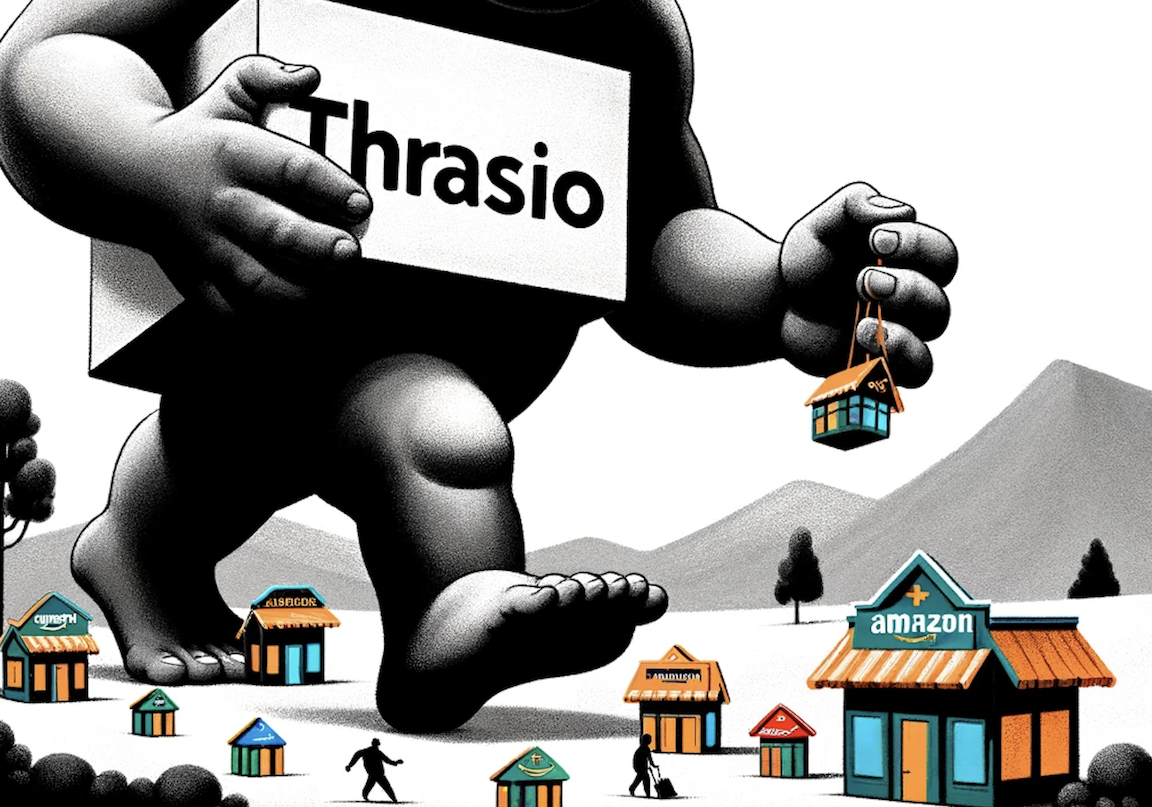Navigating Turbulence: Thrasio’s Bankruptcy and the Path Forward for Amazon Entrepreneurs
From Rapid Expansion to Restructuring: Lessons on Strategic Growth for eCommerce Sellers – Here’s How to Safeguard Your Own Brand

Thrasio, an early leader in the Amazon seller aggregation space, has filed for Chapter 11 bankruptcy protection, indicating a strategic move to restructure its finances amidst challenging market conditions.
The company has reached an agreement with its lenders to reduce its debt by approximately $495 million. Additionally, Thrasio has secured commitments for up to $90 million in new capital, aimed at supporting ongoing operations and sustaining the brands within its portfolio.
This financial restructuring is expected to strengthen Thrasio’s balance sheet and enhance its ability to support its brands, scale infrastructure, and explore new opportunities.
Thrasio’s journey reflects the broader challenges faced by Amazon aggregators, who have collectively raised billions in investor capital during the height of the third-party seller roll-up craze, only to encounter headwinds as ecommerce growth moderated post-pandemic and economic uncertainties grew.
While Amazon sellers might not be overly concerned with billion-dollar aggregator balance sheets, the trajectory of Thrasio isn’t too different from the rapid scaling experience of a lot of online sellers, albeit on a much grander scale.
In this way, the bankruptcy of Thrasio can provide critical lessons for Amazon sellers. Thrasio’s journey from a pioneering aggregator to filing for bankruptcy underscores the importance of sustainable growth strategies, prudent financial management, and the need for operational integration post-acquisition.
Here are the key takeaways for Amazon sellers:

You Need to Prioritize Sustainable Growth
Thrasio’s rapid expansion, fueled by over $3 billion in raised capital and an aggressive acquisition strategy, eventually led to financial instability. The company’s reliance on significant debt, with risky terms such as high-interest rates, coupled with a high cash burn rate, emphasizes the need for Amazon sellers to focus on sustainable growth and maintain healthy debt levels.
To create a solid foundation and a clear path to profitability, Amazon sellers can employ several strategies that prioritize long-term success over short-term growth.
Thinking About Hiring an Amazon Management Agency?
Canopy’s Partners Achieve an Average 84% Profit Increase!
Let’s talkHere are four key strategies:
Understand and Manage Your Cash Flow
Effective cash flow management is crucial for sustaining operations and funding growth initiatives. Analyze your cash flow statements to identify areas where costs can be reduced and to ensure that you have enough liquidity to cover operational expenses.
Investing in inventory management software can help optimize stock levels and reduce holding costs, thereby improving cash flow. Additionally, negotiating better payment terms with suppliers can provide more financial flexibility.
Focus on Product Quality and Differentiation
On Amazon’s crowded marketplace, offering high-quality products that meet a specific need or preference can set you apart from your competitors. Conduct thorough market research to identify gaps in the market and develop products that fill these gaps.
Invest in product innovation and seek feedback for improvement to enhance product offerings and brand reputation.
Optimize Operational Efficiency
Streamlining operations to reduce waste and increase productivity can significantly impact profitability. This includes automating repetitive tasks, optimizing supply chain management, and leveraging data analytics to make informed decisions.
For example, using automated repricing tools can ensure competitive pricing, while analytics tools can provide insights into customer behavior and inventory turnover.
Build a Strong Brand and Customer Relationship
Establishing a strong brand identity and establishing positive customer relationships are vital for long-term success on Amazon. This involves creating a compelling brand story, maintaining consistent communication across all touchpoints, and providing exceptional customer service.
Encouraging product reviews and engaging with customers through social media and email marketing can help build loyalty and trust. Additionally, leveraging Amazon’s branding tools, such as A+ Content and Brand Stores, can enhance brand visibility and attract more customers.

Build Your Brand Through Carefully Considered Processes
Post-acquisition integration of dramatically different brands was a big challenge for Thrasio. This led to huge inefficiencies and highlighted the importance of careful integration and maintaining a level of brand autonomy.
Amazon sellers should ensure that adding more products or rapidly scaling up has been strategically planned and that operational systems are aligned to avoid dilution of brand value and operational effectiveness.
To make sure that happens, Amazon sellers should consider the following two strategies:
Do Your Research
Before any acquisition or expansion, it’s crucial to conduct thorough due diligence to understand the strategic fit of the target niche or new marketplace. This process should evaluate not just financial performance, but also brand compatibility, customer base, operational processes, and potential synergies.
Develop a Strategic Integration Plan
Having a detailed integration plan is essential for aligning systems and preserving brand value during periods of rapid scaling. Key considerations include aligning product offerings, consolidating supply chain operations, and integrating customer service platforms to ensure a consistent customer experience.
By focusing on thorough due diligence and developing a strategic integration plan, you should be able to navigate the complexities of acquisitions and expansions more effectively, ensuring that your brand value and operational efficiency are not only preserved but potentially enhanced in the process.

Explore Multi-Channel Selling and Diversification
Thrasio’s struggles also point to the dangers of over-reliance on a single sales channel. As the market evolved, Thrasio faced increased competition and margin compression, exacerbated by the post-pandemic normalization of online sales.
To remain resilient in the face of market changes, Amazon sellers should consider diversifying their sales channels and adapting their business models through the following strategies:
Expand to Additional Online Marketplaces
As the 800-pound gorilla in the ecommerce space, Amazon casts a pretty large shadow. Still, there are several other platforms where your products can reach a wider – and more diversified – audience.
Platforms like eBay, Etsy, and Walmart Marketplace cater to different customer bases and may offer less competition in certain niches. By listing products on multiple platforms, you can also reduce your dependence on Amazon and tap into new customer segments.
Each platform has its unique set of rules and audiences. Adapt your strategies accordingly, such as customizing product listings and optimizing for each platform’s search algorithm.
Develop a Direct-to-Consumer (D2C) Channel
Establishing your own ecommerce website allows for direct engagement with customers, greater control over the customer experience, and higher profit margins by bypassing marketplace fees.
Utilizing website builders like Shopify or WooCommerce makes it easier than ever to create your own online store. Additionally, a D2C channel opens up opportunities to implement loyalty programs, collect valuable customer data for personalized marketing, and offer exclusive products or promotions not available on marketplaces.
Leverage Social Commerce
Social commerce is rapidly growing. Instagram, Facebook, and Pinterest allow you to market and sell your products directly through social media posts and ads.
These platforms offer powerful tools for brand storytelling, customer engagement, and targeted advertising. Furthermore, exploring emerging sales channels like live stream selling or integrating sales into blog content can attract customers in innovative ways.
It’s going to require a little homework. Adapting to these new platforms means staying current with digital marketing trends and a willingness to experiment with new content formats and sales strategies.
These lessons learned from the fall of the once-mighty Thrasio underline the importance of strategic planning, financial health, operational coherence, and the agility to adapt to changing market conditions. Amazon sellers looking to scale their operations can learn from Thrasio’s experience to build more resilient and sustainable business models.
How Canopy Management Can Help
To level up your own online-selling journey, check back here to stay in touch with the latest ecommerce news, as well as tips and strategies from some of the brightest minds in the Amazon marketplace.
If you’d like to find out more how Canopy Management can help you strategically scale your own brand, reach out to the Amazon Full Service experts here.


